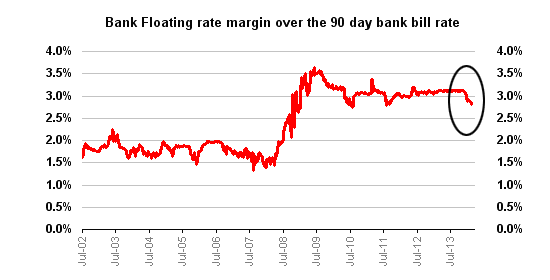
By David Chaston
Ahead of March 13, when the Reserve Bank next reviews the Official Cash Rate (OCR), we are seeing rises in 90 day bank bill rates.
Yesterday (Thursday) they reached 2.97%, the highest level since September 2011.
On December 17, 2013 that rate was only 2.70%, so markets have now priced in 25 basis points already.
The banks currently have about $78 billion on floating mortgage terms (41% of all mortgage lending) and this is essentially funded off the 90 day bank bill rate. That means, without equivalent floating mortgage rate hikes, banks are currently 'absorbing' this rise. That is an absorption of some $200 million per year, a cost they are unlikely to want to bear for too long.
However, bank margins on floating mortgages are considerably higher than on fixed rate terms.
Further, before the 2008-09 international credit crunch, bank margins were approaching half the level they are today for floating rate mortgages.
This lending is very lucrative for banks - which is no doubt why they try very hard to build their mortgage loan books.
(Technically, credit spread costs apply as well, but they have been falling recently too - even though they remain considerably higher than before 2008.)
And history shows it has been very safe lending as well, even through the toughest economic crisis in 80 years.
From July to September 2011, markets got themselves convinced an OCR rise was on the way and bid up the 90 bank bill rate then too.
But then Reserve Bank Governor Alan Bollard did not deliver the expected rise - despite his 'forward guidance' - and as soon as it was clear a rise was off the agenda, the 90 day rate fell back to the 2.5% to 2.7% levels quickly. (In fact there was even a period after that markets suspected an OCR cut, but that didn't happen either.)
Today it is hard to find an economist who does not see a rise in March.
Complicating the picture is that international money rates are not rising - which means costs for fixed rate mortgages are contained at this stage.
A March OCR hike could well also deliver that New Zealand oddity - an inverted rate curve where short rates are higher than long rates. We had that situation for many years up until 2008 even though such market signals are supposed to be 'temporary'.
The other complicating factor for the Reserve Bank is the level of the currency. A New Zealand dollar over US82 cents will be a factor in Reserve Bank Governor Graeme Wheeler's calculations.
But at some stage the monetary policy settings will need to be returned to 'normal' (or a 'new normal') and that implies a rate much higher than 2.5%. It is currently not a question of containing inflation, or even future inflationary threats; it is a question of returning the cost of money to a more normal basis. Cheap money causes people to make poor financial decisions.
If he holds back now when the economy is in an apparent virtuous cycle, when would he pull the trigger?

Bank bill rates
Select chart tabs
2 Comments
Good question Boatman, and since the financial markets have the OCR hike fully priced into rates, youve probably got to say yes, its also priced into the NZ Dollar. So a hike on the 13th and a no surprise commentary shouldn't have much impact on the Kiwi. Surprises, and subsequent events obviously could have, and on the upside or downside.

We welcome your comments below. If you are not already registered, please register to comment.
Remember we welcome robust, respectful and insightful debate. We don't welcome abusive or defamatory comments and will de-register those repeatedly making such comments. Our current comment policy is here.